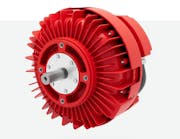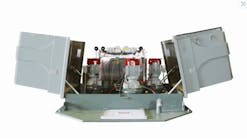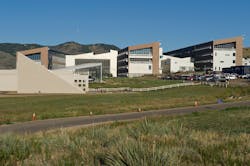According to Navigant Research,1 technology for achieving zero-net-energy (ZNE) (also known as zero-energy, net-zero-energy, or net-zero) buildings—defined by the U.S. Department of Energy2 as energy-efficient buildings “where, on a source energy basis, the actual annual delivered energy is less than or equal to the on-site renewable exported energy”—is available for most building types, but education, not to mention cost, remains a challenge. With that in mind, HPAC Engineering assembled a panel of buildings professionals well-versed on the subject of ZNE buildings and put to them a series of questions submitted by readers.
What is the estimated additional first cost of a ZNE building, and how does a ZNE building compare in terms of overall life-cycle cost? Granted, there are energy savings, but aren’t there additional maintenance costs for systems with additional components and features?
“People spend money on what they want to spend money on,” Paul Torcellini, PhD, PE, principal engineer for the National Renewable Energy Laboratory’s (NREL’s) Commercial Buildings Research Group, said. “We have found that if you have a set of energy goals within your project scope from the beginning, design teams and contractors can integrate the required 50-to-70-percent energy reduction in with little or no additional cost. The NREL RSF (Research Support Facility) is a good example of this. Most of the biggest savings items come with less maintenance.
“We have the mode that buildings that are low-energy are complex,” Torcellini continued. “It doesn’t have to be that way. Complexity costs money. Start with good envelope designs. The envelope should be the first line of defense for heating, cooling, and lighting a building. Cut out all the extra printers and appliances. Set ENERGY STAR settings on the computers. All these things reduce maintenance costs and save capital funds. I think the perception that to save energy you have to spend money—we need to use creativity to solve the problem such that saving energy also saves capital dollars. We showed that several years ago and have examples to back it up.”
Charles Eley, FAIA, architect, mechanical engineer, and author of the book “Design Professional’s Guide to Zero Net Energy Buildings,” said the maintenance costs of solar systems, common in ZNE buildings, are extremely low.
“In some areas, performance can be improved by cleaning the collectors once a year, but, apart from that, there is very little that needs to be done,” Eley said. “As for the cost-effectiveness of ZNE buildings, solar systems often can be installed at no additional cost to the owner through solar leases or power-purchase agreements. Plus, renewable-energy-system costs have declined significantly in the last decade, and further declines are expected.”
Though achieving the very low energy-utilization indexes of ZNE buildings requires “investment in better windows and envelope construction, more efficient HVAC systems, and better lighting systems and controls, minimum building codes in many areas, like California, already require levels of energy efficiency near the level needed for ZNE, so the extra cost is minimal,” Eley added.
How does a ZNE-building project stack up in terms of embodied energy on a first-cost basis and a life-cycle-cost basis?
“The embodied energy of a project is considerable, but not part of the common accounting for ZNE buildings,” Eley explained. “For new construction, the embodied energy represents many multiples of the annual operating energy. Were it to be factored into the definition of a ZNE building, the project would start off deep in the hole and would need to be a net producer for many years to achieve ZNE.
“Existing buildings,” Eley continued, “should be renovated when possible, and new buildings should be constructed to have a ‘long life, loose fit’ so they can be adapted to new and perhaps unexpected uses in the future. This will reduce embodied energy in the long term.”
Though very simple and hardly perfect, one way to think about embodied energy is in terms of cost, Torcellini said.
“If it is not cost-effective on a life cycle, you have to question if more energy goes into making the widget than it will save,” Torcellini said. “... I would argue that we don’t make other design decisions based on embodied energy. Why would you buy marble from an international source when a local product would work? Why? Because I want it! The embodied energy of just creating the building far dominates the incremental changes in the energy technologies that can be integrated.
“The other part to remember,” Torcellini added, “is that if the building is truly zero-energy, the entire impact is embodied. What we don’t often consider is that to make non-zero-energy work, there is a huge infrastructure that we don’t often think about with respect to the building. Think of the amount of effort to make a power plant or the railroad track to get coal/oil to the power plant, etc.”
Does a ZNE building require significantly more effort for performance to be sustained?
With ZNE buildings, commissioning and operator training are essential, as are leases and other contracts encouraging efficient operation, Eley said.
“The performance of ZNE buildings is verified at the meter,” Eley explained, “so a lack of commissioning and operator training will show up very quickly, where inadequate performance may go unnoticed for years with a conventional building.”
Measuring the performance of a zero-energy building does not require an expensive metering program, Torcellini said.
“Just look at 12 months of bills, and you can easily figure out if you are at zero,” Torcellini said. “It is a little more math if you have multiple fuel types, but not that hard.”
Is a change of mindset on the part of building users required to achieve and maintain the goal of ZNE?
“A change of mindset is definitely required for successful ZNE buildings,” Eley said.
Citing the example of the ZNE Bullitt Center in Seattle, in which “about half of the energy ... is ‘unregulated,’ consisting of computers, printers, coffee makers, refrigerators, and other energy uses that are more the responsibility of the occupants and tenants, as opposed to the designers and constructors of the building,” Eley said ZNE is difficult, if not impossible, to achieve without the active cooperation of tenants and occupants.
“As a result, the Bullitt Center and other ZNE buildings are exploring innovative lease arrangements that provide an incentive to the tenants to carry on efficiently and to conserve,” Eley said. “We will see much more of this in the future.”
The bottom line, Torcellini said, is: “People need to want to change. Sometimes, that happens because of price signals; sometimes, it happens because of societal pressures. Most of us don’t like any sort of discomfort, which is why more and more buildings have air conditioning, which further narrows our expectations on comfort zones. But we all have our priorities. For example, people tolerate some glare if they have a great view. Another example is if occupants control the space, we tolerate larger temperature swings—it is amazing the variability when we let people operate the windows.”
What, if anything, should employers be doing to change employee behavior to help pave the way for ZNE buildings?
Implementing “vacancy sensors on lighting, manual glare control, task cooling and lighting, mobile-workplace technologies like cell phones and laptops, and EV (electric-vehicle) charging stations,” Shanti Pless, senior engineer, NREL, said, adding people are 20 times more likely to get an EV if they have access to a charging station at work.
“Transportation energy is not factored into the common definition for ZNE buildings, but it certainly is important,” Eley said. “For some buildings, meeting the transportation demand can result in more energy use than operating the building. When a site has EV chargers, the energy they use is treated as exported energy, like excess renewable energy.”
Though encouraging the use of public transportation and carpooling and allowing employees to work from home are viable means of reducing loads and getting to ZNE, “It is important that people change because they want to, and they need the motivation to change,” Torcellini said. “... We have found that many ideas people will embrace if they understand them. We moved to laptops a few years ago, and there was very little staff pushback—and we got lots of energy savings. We moved to larger printers per wing, and employees like the speed and like the opportunity to get up and walk around. Moving to paperless workflows also helps—employees like the idea of electronic deposits, device-enabled expense reporting, etc.”
Are there preferred/recommended methods of project delivery for ZNE buildings?
“A dedicated design team, construction team, and owner can achieve ZNE with any project-delivery method, but it is easier with integrated project delivery (IPD), as recommended by The American Institute of Architects,” Eley said. “With IPD, the owner, designer, and constructor work together from the beginning to achieve the goals of the project, including ZNE. An option, or add-on, to IPD is an incentive-compensation layer that makes a portion of the fee contingent on meeting one or more of the project goals, like achieving ZNE.”
“To make integrated solutions work, we developed a performance-based design-build delivery method that rewards effective teams for delivering excellence on a project,” Torcellini said.
What are the most significant design difficulties associated with ZNE buildings?
“Achieving a low energy-utilization index and integrating solar collectors with other roof demands, like skylights and HVAC equipment,” Eley said.
Torcellini cited window sizing: “We have written algorithms to optimize building capital cost and energy goals. The results are interesting when the computer designs a building: minimal windows—just enough for daylighting—good envelopes, 50-percent reduction in plug loads, and a very efficient small HVAC system. If we started there and created beautiful buildings in that context, we would have buildings that use much less energy. If you start with a glass box that has solar heat gains and poor envelope performance—even the best glass cannot compete with an insulated wall—then hitting the goal is hard. With all that said, we probably don’t want to live in a building a computer designs; we want view glass, but it comes at a capital cost and an energy penalty. If we understand that when we are designing, we can appropriately size windows.”
It is almost a given a ZNE building will require solar, wind, and/or other forms of renewable-energy capture. With so many inverters contributing to the grid, including residential users, is there an electrical challenge to be faced by utility companies?
“Power quality can be an issue,” Eley said, “but most utilities have standards inverters must meet before a renewable-energy system can be connected to the grid.”
Said Pless: “Power quality, especially in building-scale microgrids with inverter-based generation and storage, has to be designed carefully and generally better understood.” NREL’s Energy Systems Integration Facility, which provides laboratory space and specialized scientists and engineers to aid research of new technologies, was designed with this in mind.
Most ZNE projects rely on production and export of excess solar-generated electricity during the day and the drawing of electricity from the grid at night, when the ZNE buildings need electricity for light and heat. ZNE buildings, then, rely on non-ZNE users to take the excess electricity. If everyone were to take the solar-power approach to ZNE, no one could be ZNE because there would be no pigs around to use the daytime excess solar power. What demonstrated technologies and techniques can designers use to light, heat, and cool their buildings after dark and have their buildings be truly ZNE?
“Time is not a factor in the current definition of ZNE buildings, and this will become a problem in the future,” Eley said. “Many ZNE buildings produce more energy than they use in the summer and are net consumers in the winter. Likewise, renewable-energy systems are cranking out energy on weekends, when it may not be needed by the grid. As long as there are just a few ZNE buildings, this is not a problem, since the excess renewable energy tends to align with the utility’s peak period. But if all our buildings were ZNE, it would clearly be a problem. The grid and the utilities that support it would need to function as a storage battery, taking excess energy when it is available, storing it, and serving it back at a later time.”
The long-term solution, Eley said, is real-time pricing.
“When there is no demand for renewable energy, the price would be low or even negative,” Eley said. “The peak period for many utilities would shift from the afternoon to the early evening, when the sun is down but commercial buildings are still operating. Real-time pricing would encourage building owners and managers to incorporate energy-storage systems. Batteries would be charged in the afternoon, when there is excess renewable-energy generation, and this energy would be used in the early evening, when prices are high.
“On the grid side of the meter, there also are options,” Eley continued. “Power plants that provide a base load and can’t easily be trimmed back would be retired and replaced with plants that can respond more quickly to changes in loads. Demand-response programs can be automated with the Internet of Things. There also are storage options on the grid side. Pumped storage has been used for decades, and some utilities are experimenting with batteries.”
Said Torcellini: “Moving to lower-energy buildings and renewable energy is dependent on constant technology development as well as market drivers that are governed by price and policy. Solar has become inexpensive, and adoption depends on the buy/sell that you mention. The next frontier is in storage, and that can take many forms and help to minimize the buy/sell.”
Pless concurred: “We are seeing lots of interest in storage at the grid scale and the building scale. Pumped hydro, large-scale batteries, ice storage, and hot-water storage are all examples.”
What level of energy use do you look to achieve before adding renewables?
“EUI (energy-use intensity) targets vary by building type and some by climate, but for offices, retail, and schools, site EUIs should be in the range of 15 to 25 kBtu per square foot per year,” Eley offered.
Said Torcellini: “Our general recommendation is about a 50-to-70-percent reduction from current codes and building standards. For many commercial-building types, this is an EUI of 20 to 25 kBtu per square foot.”
Pless added: “I look for best in class for my building peer as a comparable. New Buildings Institute’s Zero Net Energy database and Advanced Buildings database are good places to start. ASHRAE’s Advanced Energy Design Guides (AEDGs) also have EUIs by building type and climate zone.”
Are there geographical belts being identified as prime regions for implementation of ZNE buildings?
ZNE can be achieved in all climates, though more easily in some than in others, Eley said.
“In my book, I do an analysis by climate,” Eley said. “The most difficult climate is the arctic regions. The cold and humid climates of the Northeast and Great Lakes areas provide the next level of difficulty. The Pacific Coast—mild temperatures—and the Southwest areas—lots of sun—are the easiest.”
Torcellini agreed: “We can make zero-energy work in most climates. The hardest ones are cold, northern climates where solar availability is limited and heating loads are high. With that in mind, mild climates should have limited excuse not to make zero-energy buildings.”
It is not all about climate.
“Local advantageous policies, utility costs, a local capable design and construction industry, and utility incentives have created pockets of prime regions for zero,” Pless said.
For ZNE buildings, ground-source HVAC equipment is reasonable to expect. Are there any concerns about possible long-term ill effects on geology? For geothermal systems designed for campus-type environments, are operators seeing elevated condenser-water temperatures necessitating backup measures, such as dry coolers?
“It is true that many ZNE buildings use ground-source heat pumps (GSHPs) because they are more efficient than many other system types,” Eley said. “The temperature around the wells can drift up or get colder over time, if there is not a balance of heating and cooling loads over a typical year. The best applications for GSHPs are in climates where heat rejection is about equal to heat absorption on an annual basis.”
Said Pless: “In buildings or climate zones with unbalanced annual heat extraction to heat rejection, hybrid ground-source-heat-pump systems often are considered. A fluid cooler or backup boiler can help to restore annual heat balance and maintain sufficient water-loop temperature ranges.”
Above all, Torcellini said, the long-term success of a system is dependent on good engineering and contracting.
“Balance the heating and cooling,” Torcellini said. “The amount of ground water makes a huge difference on ground properties. As with any other system, expertise goes a long way here. On the flip side, mechanical systems should not be used as a solution to poor energy efficiency in an envelope. The downsizing of HVAC is an important strategy for zero energy. For example, in my house, my loads are so small that a small air-based heat pump meets the load, and the efficiency of that unit is quite impressive. Drilling wells would have been very expensive.”
What innovations have you incorporated into your designs to achieve ZNE?
“Aggressive heat recovery from data centers, telecom, exhaust air, solar gains,” Pless said.
“Using daylighting fenestration for daylighting and ‘windows’ for view glass,” Torcellini added. “... Mov(ing) to a mode where the building turns off when it is unoccupied. ... Reduc(ing) plug loads. We have been involved with some projects where we basically eliminated the HVAC system. Mov(ing) to hydronic-based systems, rather than air-based systems. Mov(ing) to radiance comfort, rather than focusing on air temperature. Let(ting) the occupants control their space conditions.”
Do you think ZNE is a reasonable design goal for new buildings?
“It’s a reasonable goal for the vast majority of new buildings,” Eley said. “The exceptions are high-rise buildings, along with restaurants, supermarkets, health care, data centers, and other energy-intensive buildings. For them, community solar and other off-site options are available.”
Pless said ZNE is most difficult to achieve with laboratories, hospitals, and high-rises.
“But even for these more difficult buildings,” Torcellini said, “there is no reason not to specify an EUI target in the 50-percent-savings range.”
Do you expect ZNE to substitute for LEED (Leadership in Energy and Environmental Design) certification of buildings?
“ZNE addresses just one aspect of green buildings: energy,” Eley said. “LEED considers water, sites, materials, and much more. I don’t think ZNE will be a substitute for LEED.”
A more likely scenario, Eley said, is ZNE becoming a qualification for energy points in future versions of LEED.
Pless said other programs, such as the International Living Future Institute’s Living Building Challenge and the WELL Building Standard, also will continue to have a place.
“The different programs often highlight different metrics, all of which are important,” Torcellini said, echoing Eley. “One is not necessarily a substitute for another. I would add to the list ANSI/ASHRAE/USGBC/IES 189.1, Standard for the Design of High-Performance, Green Buildings Except Low-Rise Residential Buildings.”
What advice would you give to engineers and designers looking to achieve ZNE goals using current technologies?
“Make a commitment to the ZNE goal early in the design process,” Eley said. “Design to the latest energy-efficiency codes, and push as far past those codes as you can. Incorporate on-site renewable energy on the building roof and/or over parking and on the building grounds.”
“Set EUI goals, not percent-savings goals,” Torcellini said. “An EUI goal will focus the team on meeting that goal. You can base that on percent savings, but the owner should set that goal. As stated earlier, start with good envelope design.”
Pless advised beginning one’s ZNE journey with the AEDGs.
References
1) Navigant Research. (2016). Net zero energy buildings. Available at http://www.navigantresearch.com/research/net-zero-energy-buildings
2) DOE. (2015). A common definition for zero energy buildings. Retrieved from https://energy.gov/sites/prod/files/2015/09/f26/bto_common_definition_zero_energy_buildings_093015.pdf
Did you find this article useful? Send comments and suggestions to Executive Editor Scott Arnold at [email protected].
SIDEBAR: The Panel
Charles Eley, FAIA, is an architect, mechanical engineer, and author with 40 years of experience in energy-efficient and sustainable design. His latest book is “Design Professional’s Guide to Zero Net Energy Buildings” (Island Press, 2016). During his career, he has made significant contributions to various energy standards, developed energy-analysis software, and consulted on landmark energy-efficient buildings.
















